|
|
Greetings to all readers.
Japan has always had its own way of doing things. Some of
those ways survived the tides of time; some did not. But one thing that remained transferable across the cultural upheaval of the centuries and at the same time traversed cultural boundaries was the awareness of the seasons. One that did not was the seasonally-attuned naming of the months of the year.
Currently, Japan uses names for the months of the year that are simple in that they are all named for the numerical order in which they occur; January is “1st Month,” (Ichigatsu), February is “2nd Month,” (Nigatsu). And so on. But it wasn’t always this way. In fact, there is an old calendar, an officially defunct but culturally still alive system of naming the months. Rocket science it ain’t: it works with the moon and the tides of the seasons like all traditional calendars do. But culturally revealing it is.
Most relevantly, December is “Junigatsu,” or “12th Month” in modern parlance, but is known by the etymologically appealing term “Shiwasu” in the old calendar. The word Shiwasu is composed of two characters, the first being teacher or mentor, the second being run. Much becomes clear right there.
In other words, the name for the final month of the year - or perhaps more relevantly the last month before the start of the new year - implies that everyone is so busy that even the teacher (who usually has things done by underlings) is running around. There are, of course, other interpretations, but this is the most common and the most interesting.
And, as usual, the Shiwasu season is living up to its billing. Happy running-around to all readers.
Enjoy the newsletter,
Warm regards,
John
 
|

Rice to Sake: How much? Does some sake use more rice than other sake?
I recently received an email from a Japan-based reader that asked
about how much rice goes into a bottle of sake.
It read: “I am drinking a ginjo at 60% - it tastes fine, but watered down. (It was cheapish.) I am wondering how much (little) rice was used. I want a percentage stated on the label. My question: Is it possible to grind rice down to a low value to attract buyers, call it ginjo, and use less rice than usual? Any standards for this? Does ginjo use more rice than futsu?”
The short answer is that yes, some sake uses more rice than other sake, for sure. This is true, even though it is not how they measure it.
They (the sake-brewing industry) could, but it is not the angle that they take. Rather than talk about how much rice went into a bottle or batch, they speak of how much milling, how much post-fermentation dregs, added alcohol, and amino acid content. And not surprisingly, it is a deceivingly complex question.
To answer it properly, let us look at it a couple of ways. First off, when talking about how much rice goes into a bottle of sake, we need to specify brown (i.e. before milling) rice or white (i.e. after milling rice).
For example, take a ton of brown (unmilled, just harvested) rice. For cheap sake they might mill just 20% away, leaving 80% of the raw materials for the tanks. For daiginjo they might mill away 65%, leaving just 35% of the original raw materials for the same tanks. If the yields were the same for two given batches, then right then and there we see much more brown rice would be needed to make a one-ton batch if you end up milling more of it away before beginning. But that much should be fairly obvious. So let us look at after milling, i.e. the already-milled white rice that goes into a batch.
The next factor to consider is almost as obvious: is it a rice-only sake (junmai, junmai ginjo, or junmai daiginjo) or did they add alcohol to it (honjozo, ginjo, or daiginjo, or even a lowly futsu-shu)? When alcohol is added to sake, they do it at the end, stretching out yields. While that yield improvement is not the objective in premium sake, it nevertheless is real. So yes, if you are drinking a junmai style sake, if all other things were equal, they would have used much more rice in making it.

So, our friend’s watered-down, cheapish ginjo may have been a non-junmai. This would indicate less rice was used.
A caveat is important here: this is not meant to imply that adding alcohol thins out flavor. It might. It can. But it does not have to. Too many other things affect flavor. Most significantly, it may just have been a regional or brewer-specific style.
Next on the list is: how fully did they ferment the rice that was used? In other words, a brewer can let or force a tank of fermenting mash go so long that they get every possible drop of alcohol that is physically possible out of the rice. Even within this point, there are several sub-points, but let us say they control starch to sugar conversion so as to maximize the amount of sugar from every grain of rice, and let the alcohol run up to 20%, whereupon the yeast throws in the towel and dies. The other end of the spectrum is sake in which not all the starch was even saccharified and/or the fermentation was curtailed at, say, 17% alcohol. Trust me, the latter will taste better. But it will call for much more rice to make a bottle of it. Even though that is not how they measure it.
How do they measure it? Most relevant to the above example, they weigh the dregs after brewing (kasu) and compare it to the weight of the original rice. The lighter the dregs, the more they got out of their rice, and the less rice they had to use to get it. And the heavier the dregs, the less they got out of their rice, and the more rice they had to use to get it.
Finally, there are other factors that affect the sensations of heaviness, richness, thickness and the lack thereof in a sake. For example, amino acids created by the koji, acids created by the yeast, and non fermentable touchy-feely-to-the-tongue sugars created by the enzymes from the koji can all add to the sense of thick or thin, heavy or light, clean or cloying, in a sake. So two sake with the same rice, same milling, and even same amount of dregs remaining can taste different in this aspect based on any or all of the above factors. It is not just the rice.
And just to be annoying and to complicate things more, maturation, pasteurization, filtration and half a dozen other “-ion” steps involved can have the same affect on the thick/thin heavy/light, rich/light, clean/cloying continuums. And these have nothing to do with the amount of rice used.
So back to the original questions as stated:
Is it possible to grind rice down to a low value to attract buyers, call it ginjo, and use less rice than usual? Answer: Yes, it is. They can add more or less alcohol, or ferment the rice they choose to use more or less thoroughly.
Any standards for this? Answer: No, no standards for this. But since they measure the same thing in other ways, none are really needed, methinks. That is why we cannot depend on the milling rate alone!
Does ginjo use more rice than futsu? Answer: Hell, yes! No matter how you slice it, yes!
So yes, some sake does use more rice than other sake. And some ginjo uses more rice than other ginjo. But while this is true, there are many things that affect flavor and quality before this, and rather than measure how much rice goes into a bottle, there are a dozen other things (weight of the dregs, how far fermentation is allowed to proceed, compounds produced during fermentation) that they do look at and keep track of.
Like most things sake related, there is a simple short answer, and one that is much more deep and complex. And, like most sake itself, the only really factor worth measuring is the “ I-like-it-meter” reading once you’ve tasted it. If that puppy is pegged, you’re golden.
|
 Sake Basics Sake Basics
Multiple Parallel Fermentation
Sake 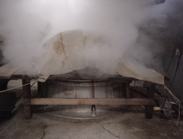 is the only marketed alcoholic beverage in the world that is
produced by “multiple parallel fermentation.” Just what does that mean? is the only marketed alcoholic beverage in the world that is
produced by “multiple parallel fermentation.” Just what does that mean?
Wine is made using grape juice that has sugar in it already. Yeast takes in this sugar and gives off alcohol. This is chemically a simple fermentation. Beer starts with barley that has starch, which yeast cells cannot deal with. So enzymes in the malted barley chop the starch to sugar first. After that is done, then yeast converts that sugar to alcohol. So, in beer, starch-to-sugar and sugar-to-alcohol are sequential and separate.
In sake, enzymes from the koji mold chop starch in the rice into sugar, but this happens in the same tank and at the same time as the yeast converts that steady stream of developing sugar into alcohol So in sake, starch-to-sugar and sugar-to-alcohol take place at the same time, and in the same tank. This is called in Japanese heikou fuku hakkou , or “multiple parallel fermentation,” and is unique to sake in marketed alcoholic beverages.
|
 Did You Know? Did You Know?
Sake Kasu
Nothing goes to waste in the sake-brewing process.
After fermentation is complete, some of the rice that did not or could
not ferment (or was not permitted to ferment!) remains. When the slightly amber sake is pressed away, these lees, or “kasu,” remain. Kasu can be very tightly packed, or somewhat loose, depending on the pressing process used. They are in great demand today!
Kasu can be used in many ways in cooking, and its health benefits are being touted quite a bit. While some of those have yet to be scientifically authenticated, the liveliness and pizzazz it can bring to food is tremendous.
It is most commonly dissolved in miso soup (often with salmon) in what is called kasu-jiru. It can also be spread on fish as a marinade before grilling (yum!), and also mixed with water, honey and ginger to make one form of a drink called ama-zake, drunk warm on cold winter nights at festivals and such. There are many other non-traditional and just plain creative ways to enjoy kasu too. One I like is to spread miso on firm kasu and lightly fry it. A great sake accompaniment!
Sake kasu is fairly easy to find at Japanese grocery stores, particularly in the winter.
|
 Announcements and Events Announcements and Events
Sake Professional Course 2011, Japan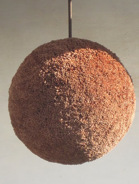
January 24-28, 2011
"No sake stone remains left unturned."
It is my pleasure to announce the 8th annual Sake Professional Course to be held in Japan. This is it, folks: the most important thing I do all year, and far and away the best possible sake education in existence. Three days of lecture and tasting, each evening capped off with dinner and fine sake, then two days spent visiting four sake breweries of different size and scale - punctuated again with fine sake and a great meal each evening. Of course, certification testing for a Certified Sake Professional is a part of the event.
Word travels fast, and as of today only ten eight (8) spots have already been reserved. If you are interested, please send an email to me at info@sake-world.com right away. Feel free to ask any and all questions or make any inquiries about the course as well. To learn more about the schedule and details, check this out.
Trust me when I say - for sake education - it does not get any better than this. Alternatively you can see what others have said.
Sake Tours!
Please join us for a very special journey through the regional
brewing and culinary traditions of Japan. Tour destinations are filled with moments you cannot experience otherwise. In 2011, we will return to San-in, the land of myth. And, we are adding a tour of the northern snow country of Akita for special breweries and onsen.
Meet and speak directly with artisans to appreciate their history, philosophy, and the art of brewing. Learn from the world's best sake educator, John Gaunter, and share the passion of brewers for their craft. Then, wind down at an onsen to relax, and simply have fun! Learn more at http://saketours.com .
|
 Sake Education Central Sake Education Central
Special Holiday Sale
'Tis the season to learn about sake!
Just a heads up to look for a special, first-ever, holiday sake on all
sake education products herein. A separate notice will go out once the
details are decided.
Want to learn all the basic sake facts quickly? Just what you need to enjoy it immediately? Need neither too much nor too little information? Grab The Sake Notebook. Download it at 4pm an d you will be ready to enjoy sake at dinner. Guaranteed!
The Sake Production Slideshow allows you to sit back, relax and watch a beautiful, condensed powerpoint presentation of how sake is produced.
Japanese for Sake Lovers not only teaches sake pron unciation, it includes a native speaker pronouncing the words with a time lapse for your practice. You not only learn how to speak “sake”, you learn proper Japanese pronunciation without the cost of a Japanese language course!
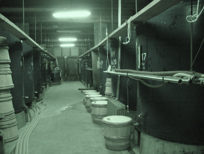 Do you w ant to know the “behind the scenes” secrets of the master brewers? Read the untold stories of sake brewers in Sake’s Hidden Stories. Each of the dozen-odd stories introduces a brewer, the sake, and tons of subtle, hidden insights and sake information you'll not find in any other book about sake. Guaranteed.
Going to Japan or a Japanese restaurant? Perhaps you’re in the mood for sushi and sake at home. Do you know what to look for and how to ask for it? You will when you tote around more than 200 terms in your pdf or iPhone with The Sake Dictionary.
Product Highlight: Japanese For Sake Lovers A Guide to Proper Pronunciation Here it is: something that ensures you will enjoy your sake experience more and more - a short, concise instructional guide on how to properly and naturally pronounce the Japanese language, sake brand names, and all the terminology that is a part of the sake world. With the help of this little course, you will sound like a native when talking about sake.
No more butchering sake names in Japanese! Learn how to properly pronounce the sake you love!
Japanese for Sake Lovers consists of a short text and three audio files. It all begins with a guide to the theory of pronouncing Japanese, which you will soon realize is surprisingly simple. Following that, you will have the opportunity to practice pronunciation of all the important terminology surrounding sake, and dozens of brand names that cement in your mind the principles, fundamentals, and idiosyncrasies of pronouncing Japanese.
This is not a language text. You will not learn grammar or much 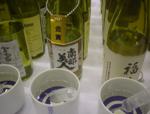 vocabulary outside of sake-specific terms; although, it does include a handful of phrases to help you navigate your way to sake bliss in Japanese when at a sake pub. It is augmented by three audio files that allow you to practice, repeating the words and phrases after a native speaker.
Go here now to order your copy for $14.99, and feel one step closer to the beverage you love – guaranteed.
*Satisfaction
Guaranteed*
Should any of the above products not be to your immense satisfaction, your money will be cheerfully refunded, no
questions asked.
|
Stay Subscribed!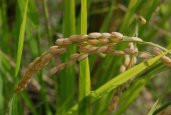
Are you not getting this newsletter? I realize that is like asking that "those not present please raise your hand," but for future reference, should you spontaneously stop receiving this newsletter, please go here and sign up again. Should that not work, please go to www.sake-world.com.
Email newsletter services are very careful not to be considered spam enablers, but the problem is that often very valid email addresses come back bounced as invalid. It is an unavoidable problem. So if you or someone you know is not getting this, or stop(s) receiving it inexplicably, please do take a moment to double check that you are still subscribed.
Sincere apologies for the hassle, mixed with gratitude for reading this newsletter.
|
I hope you have found the above information helpful and entertaining. For more information about all things sake, please check out www.sake-world.com. Until next month, warm regards, and enjoy your sake. 
Questions and comments should be directed to John Gauntner, at this email address.
All material Copyright, John Gauntner & Sake World Inc.
Regards,
John Gauntner
Sake World, Inc
 . . 
|
|
